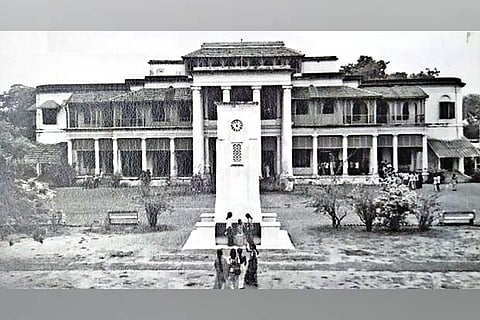

Chennai
A few decades after the College of Fort St George, the first college in Madras opened by the East India Company to train the new recruits in local languages, was permanently padlocked, another was started on this road – thoughtfully remembered as College Road. This time, it was a private women’s college, the second one in the city after Queen Mary’s College. Started in 1915, the new institution was named the Women’s Christian College.
It was initially functioning from a rented premise in Hyde Park in Kilpauk with 41 students, before a lump sum donation by the Rockefellers from the US enabled the missionaries to buy the Doveton House and its 11 acres in Nungambakkam. Interestingly, exactly 200 years before the Americans funded this college in Madras, a donation from a British Governor of Madras had funded an American university named after him – what now is the prestigious Yale University.
The stately Doveton House overlooking Cooum river was used by the British to house exiles. However, Edward Clive, the Governor of Madras, had reportedly housed an Indian paramour on these grounds in the interregnum. Stories about the ghosts of the couple and their chocolate coloured baby were reportedly seen by inmates for several centuries.
Doveton House was where the children of Tipu Sultan were exiled in exchange for the good behaviour of the tiger of Mysore. Another interesting person exiled here was Malhar Rao, the Gaekwad of Baroda. Not liking the British Resident, he tried to poison him the traditional Indian royal way – powdered diamond in sherbet. But the Resident survived, and when the trial proved Malhar Rao guilty, he was dethroned and sent to Doveton House to spend the rest of his life. He built a monkey house for amusement (the building survived till recently).
Doveton House has an elephant portico through which an elephant with a howdah and passengers could walk in without hitting their heads. When the college started functioning there, instead of the pachyderms there were two 1920 model Chevrolet open-top cars that were nicknamed Jack and Jill by the students. Now Doveton House is in excellent condition, being used as the administrative wing of the college.
Just before the college started, the Indian National Congress met here for its annual meet in 1914.
The college was started with 41 students, a number that increased after it moved to the new premise. Besides the 11-acre campus, numerous buildings and neighbouring lands were acquired, including the Hanson’s Garden and the river lands, making it 20 acres in all.
Many of the day scholars may have used boats to cross the Cooum river during monsoon times. During summers, some girls waded across for a snack or to meet their tailors in Spur Tank –unmindful of crocodiles. The last crocodile in the river was sighted less than half a century ago.
The college management was very keen the students meet with every section of people. It invited nationalist leaders as well to talk to the students. When Mahatma Gandhi visited the college, the girls rushed back to the hostel to change to khadi clothes and the choir sang “Abide With Me”, said to be the Mahatma’s favourite. When Rabindranath Tagore visited the campus, he sang a song for the students.
During the World War 2, like many other buildings in Madras, the army took over a part of the college. Soldiers moved around and internees, perhaps prisoners of war, were locked up in the class rooms. But the college went on to function, with blackened windows.
The Quit India movement was a turbulent time. The staff were mostly British or pro government while the students agitated for independence. Restricted from taking out processions by the principal Eleanor Rivet, the students decided to go on a hunger strike. When reported widely in the paper, it caused a great deal of embarrassment for the staff. The principal clarified to the press it was just a fast and not a hunger strike.
But when freedom came, it was Eleanor who climbed on the terrace of the science block and hoisted the tricolour.
The initial rules of the college included a curious but strict condition that the principal should remain single and stay on the campus. Renuka Mukherjee, a dynamic principal fromLucknow, was forced to resign in 1965 when she chose to marry. Six years later, the rule was amended and Renuka returned to serve another term that lasted 10 years.
WCC has created business leaders, professors and scientists. In fact, Rukmani Lakshmipathi, who was among the first batch of 41 students, went on to become India’s first female political prisoner fighting for India’s freedom.
—The author is a historian
Visit news.dtnext.in to explore our interactive epaper!
Download the DT Next app for more exciting features!
Click here for iOS
Click here for Android